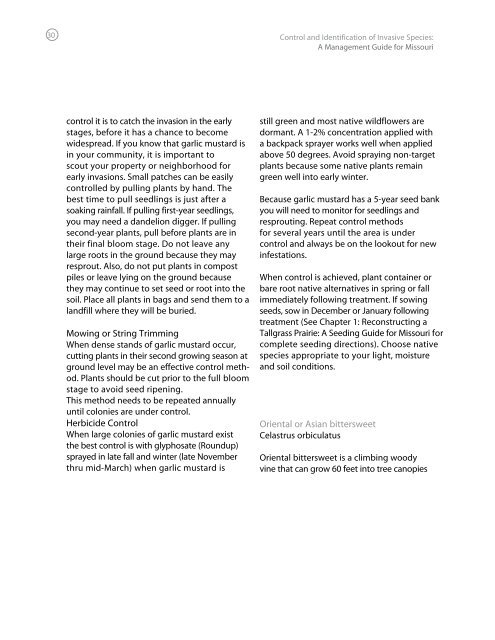Control and Identification of Invasive Species - Grow Native
Control and Identification of Invasive Species - Grow Native
Control and Identification of Invasive Species - Grow Native
Create successful ePaper yourself
Turn your PDF publications into a flip-book with our unique Google optimized e-Paper software.
30<strong>Control</strong> <strong>and</strong> <strong>Identification</strong> <strong>of</strong> <strong>Invasive</strong> <strong>Species</strong>:A Management Guide for Missouricontrol it is to catch the invasion in the earlystages, before it has a chance to becomewidespread. If you know that garlic mustard isin your community, it is important toscout your property or neighborhood forearly invasions. Small patches can be easilycontrolled by pulling plants by h<strong>and</strong>. Thebest time to pull seedlings is just after asoaking rainfall. If pulling first-year seedlings,you may need a d<strong>and</strong>elion digger. If pullingsecond-year plants, pull before plants are intheir final bloom stage. Do not leave anylarge roots in the ground because they mayresprout. Also, do not put plants in compostpiles or leave lying on the ground becausethey may continue to set seed or root into thesoil. Place all plants in bags <strong>and</strong> send them to al<strong>and</strong>fill where they will be buried.Mowing or String TrimmingWhen dense st<strong>and</strong>s <strong>of</strong> garlic mustard occur,cutting plants in their second growing season atground level may be an effective control method.Plants should be cut prior to the full bloomstage to avoid seed ripening.This method needs to be repeated annuallyuntil colonies are under control.Herbicide <strong>Control</strong>When large colonies <strong>of</strong> garlic mustard existthe best control is with glyphosate (Roundup)sprayed in late fall <strong>and</strong> winter (late Novemberthru mid-March) when garlic mustard isstill green <strong>and</strong> most native wildflowers aredormant. A 1-2% concentration applied witha backpack sprayer works well when appliedabove 50 degrees. Avoid spraying non-targetplants because some native plants remaingreen well into early winter.Because garlic mustard has a 5-year seed bankyou will need to monitor for seedlings <strong>and</strong>resprouting. Repeat control methodsfor several years until the area is undercontrol <strong>and</strong> always be on the lookout for newinfestations.When control is achieved, plant container orbare root native alternatives in spring or fallimmediately following treatment. If sowingseeds, sow in December or January followingtreatment (See Chapter 1: Reconstructing aTallgrass Prairie: A Seeding Guide for Missouri forcomplete seeding directions). Choose nativespecies appropriate to your light, moisture<strong>and</strong> soil conditions.Oriental or Asian bittersweetCelastrus orbiculatusOriental bittersweet is a climbing woodyvine that can grow 60 feet into tree canopies


